(page 21)
November 3, 2004
Cursory
Tired, little motivation. Did some standard rehab stuff, then played around with doing a little of this and that including deadlifts, zercher squats and even some good mornings - all with a bar bending load of 40 kg/88 lbs. No complaints from the back department, so unracked again for a few deep sets of pause squats. Perhaps time to attempt a slow return to heavier weights again before the circle closes.
Muscle activation, lat pulley: 25 reps each of facing, right and left @ 15 kg/33 lbs
Upper body cable turn: 25 @ 40 kg/88 lbs, 20 @ 50 kg/111 lbs
Various lower body movements with 40 kg/88 lbs bar
Pause squat: 3x5 @ 45 kg/99 lbs
Barbell side bend: 3x10 @ 30 kg/66 lbs
Twisting incline board sit-up: 10
Total training time: 55 sleepy minutes
November 1, 2004
Turning theory into practice - 102.5 kg!!
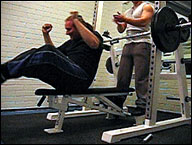 The curse has been lifted!
The curse has been lifted!
I now understand precisely what Simmons means by “standing up on the shoulders”. The arch might not seem too severe, but since the butt is now only lightly touching the bench I only have two points of stable contact: feet on the ground and traps/neck on the bench. Getting into the new position was easy after a few practice swings, but once there I was a blowfish out of water.
Slowly worked up in weight, beginning with several sets with an empty bar, while keeping toes in the air to make sure I was only driving from the heels. I felt like I had zero explosiveness and missed my old groove more than a bit, but eventually found myself at 95 kg/210 lbs. Since it went up without too much effort, I figured I could just as well follow The way of the Fool and max out despite feeling like a monkey straddling a canyon.
Went up in 2.5 kg/5.5 lbs increments. A couple of sets later I was faced with the menacing 100 kg/221 lbs. The bar path was horrible, but quite easily muscled it to lockout. Continued on to a strenuous rep at 102.5 kg/227 lbs and then failed at 105 kg/232 (VIDEO 3MB). Whoa! Eye of the tiny Tiger!
In retrospect, I’d say that getting the weight further up on the back definitively makes the lift a bit easier. At the same time I am stronger than ever, which seems to tell me that the full implications of this little but significant change have yet to be realized. Give me some time to get comfortable in this position and re-calibrate my groove and you’ll see the weights jump a bit further. If I wouldn’t have done so many tiring sets before 105 kg/232 lbs I’m pretty sure at least that would have made it to the top. Tempting as it would be to switch back to Westside with all its max attempts, I will forge ahead with Blakley for the time being. If I keep the momentum going I’ll soon be repping with my former max. That would serve it right!
Technique training working up to 90 kg/199 lbs with toes in the air
Singles:
1 @ 95 kg/210 lbs
1 @ 97.5 kg/216 lbs
1 @ 100 kg/221 lbs PR!
1 @ 102.5 kg/227 lbs PR!
0 @ 105 kg/232 lbs
A few sets of pulldowns and rope pulls
Total training time: 40 min
October 31, 2004
Heels and traps: Further lessons in the art of heavy benching
Got some more feedback on Monday’s bench video from Mike who contacted me earlier about obtaining the XTM video. While stationed with the army in California, he trained with mega-bencher Scot Mendelson, a Blakley protégé, for a year and apparently reached a 475 lbs/215 kg raw bench in the process. A couple of weeks ago he also embarked on the Blakley 4x6 program, which you can read more about in his log over at Monster Muscle. He graciously gave me permission to publish his comments:
Examined your benching video. Your form seems very good. I am also a fairly flat backed bencher with feet flat, although I flare my elbows a bit more than you (If you saw my shoulders you’d realize why). Anyway, I wish there was some critiquing I could do, but your form does look flawless. I couldn’t tell on the tape but the only suggestion I would make would be to try and get up on your traps more and pull your shoulder blades together throughout the lift. It seems tough but you need to get extremely strong rear delts to do this right. I do the reverse pec dec with over 300 lbs. for 8-10 reps. Until next time, good lifting.
Mike also mentioned that he really likes Ryan Kennelly’s benching style (video of Ryan benching a 600 lbs/271 kg double raw) and added that it mimics the form of past greats Ken Lain and Chris Confessore. This inspired me to deshelf my copy of Kennelly’s book (perhaps better called a booklet of 55 pages) The Kennelly method to reread his pointers on technique. Kennelly advocates arching with feet flat on the ground with vertical shins and pressing the bar straight up from the point where the stomach meets the chest muscles. His thoughts on foot placement caught my attention:
In my opinion, your feet should be straight in line with your knee, with toes pointing out if you don’t have a problem with your butt coming off the bench. If you have this problem, then point your toes inward a little. But, try to keep all the pressure and pressing coming from the heels, that’s were the power is.
Kennelly, Ryan: The Kennelly Method, pp 42-43
Never heard about driving with the heels before. At least that’s what I thought until I did a quick google search for bench heels westside and found the first link pointing back to an entry in my own blog where I cite Tate: “Learn to drive your shoulder blades into the bench by driving your heels into the floor”. This particular entry dates back to when I had just began the transition to powerlifting and had to learn to bench from scratch. At the time, I probably figured heels equals feet and got busy with the big questions on what to make of elbows and arches. When I later gleaned more knowledge from the Westside benching tapes and Blakley’s Building the Perfect Beast there was no mention of heels either; the former didn’t say much explicit about technique in the first place, and Blakley’s extensive analysis didn’t concern itself with heels either since he advocates benching with feet tucked back on the toes. If Tate had advocated benching with eels instead it might have stuck.
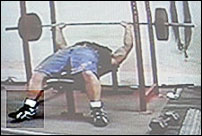 My interpretation of leg drive has been to push with feet as a whole back towards the shoulders to help support the moderate arch. Pressing from the heels seem to imply pressing more up than back, which in turn would probably help get the weight further back on the traps as opposed to the shoulder blades. Brushed the dust off the Westside Barbell Bench Press Secrets tape and began watching the first segment of world record holders George Halbert and Kenny Patterson going through a speed benching workout. Superficially, my form resembled theirs in terms of elbow tucking (if anything they tuck less), foot placement (they seem to have shins a bit more vertical than I do) and bar path (nearly straight up with a tad of drift back at lockout). Then suddenly I saw George Halbert doing a set where the toes of his left foot actually came off the ground on the ascent of every rep (highlighted in picture). This only happens on one set, but it clearly shows how redundant the rest of the foot is; the toes could just as well be pointed upwards. Guess who will try benching with toes in the air on Monday?
My interpretation of leg drive has been to push with feet as a whole back towards the shoulders to help support the moderate arch. Pressing from the heels seem to imply pressing more up than back, which in turn would probably help get the weight further back on the traps as opposed to the shoulder blades. Brushed the dust off the Westside Barbell Bench Press Secrets tape and began watching the first segment of world record holders George Halbert and Kenny Patterson going through a speed benching workout. Superficially, my form resembled theirs in terms of elbow tucking (if anything they tuck less), foot placement (they seem to have shins a bit more vertical than I do) and bar path (nearly straight up with a tad of drift back at lockout). Then suddenly I saw George Halbert doing a set where the toes of his left foot actually came off the ground on the ascent of every rep (highlighted in picture). This only happens on one set, but it clearly shows how redundant the rest of the foot is; the toes could just as well be pointed upwards. Guess who will try benching with toes in the air on Monday?
Another thing I need to relearn is how to set up on the bench. I thought I got the weight about where it should be by just wiggling my shoulders into place with back on the bench, but in retrospect I now understand that getting the weight on the traps is a fully other matter. Quoting Kennelly again:
When you set up on the bench, grip the bar and pull yourself all the way back until the bar is over your upper stomach. Then swing up and away from the bench and come down on your upper back instead of flat on your shoulder blades.
Kennelly, Ryan: The Kennelly Method, pp 42-43
Indeed, this is the way most experienced benchers seem to set up. The screenshots from Bench Press Secrets shows how Kenny Patterson does it.

As a side point, Blakley suggests doing a few light sets in the bridge position Patterson is in the first picture to learn how it should feel to have the weight on the traps/neck area. The same feeling should then be strived for with feet on the ground. I actually did this way back, but never realized that my weight was not in the same place with feet on the ground, i.e. on the shoulders instead of traps.
Getting up on the traps not only hinges around technique; you also got to have something there to provide a stable base.
When we do upper back and rear delt work it is for size, thickness. You must have a tremendous upper back to be a big bench presser. You cannot take a weight up and get flat down. You have to be able to stand up on your shoulders.
Louie Simmons on Westside Barbell Bench Press Workout, tape I
Stability. This is also where the rear delts Mike talks about come in. On Building the Perfect Beast, Blakley does a great job of showing how the shoulders should be pulled in on the bench to get a measure of support from the bench itself. If this is not done, one will “bench into nothing” since the shoulders are essentially hanging in the air with no bench contact. Keeping them in takes strength.
The plan
1) Practice pushing from the heels by keeping toes in the air (if feasible) for the next few weeks. I might also need to pull feet in a few centimeters to get shins roughly vertical to better support leg drive towards the ceiling as opposed to straight back.
2) Learn how to get up on the traps instead of the shoulder blades. First do some light benching in a bridge position with feet on the bench to get the right feel, then try to get into the same position by swinging the upper back into place instead of just wiggling into position.
3) Focus a bit more on the rear delts for the time being. Since I’m not doing much direct shoulder work at the moment, I could start working them twice a week along with the back. For both rear delt and back work keep the reps around 8 to focus on hypertrophy (size).
4) Try to retain the current elbow tucking and bar path despite the other changes.
Big thanks to Mike and Scott for helping me see a bit more light.
October 29, 2004
One week’s ceiling is another week’s floor
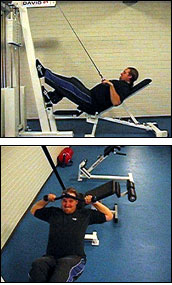 Wednesday rehab fell by the wayside of yet another extremely busy week. Spent the previous weekend at the summer cottage, so no rehab then either. Swift amends must be made.
Wednesday rehab fell by the wayside of yet another extremely busy week. Spent the previous weekend at the summer cottage, so no rehab then either. Swift amends must be made.
Heavy eye lids notwithstanding, the recent surge in progress continued on the floor press with 4x6 @ 87.5 kg/193 lbs falling on the first attempt at this weight. It was stiffer, but it was not tight. Next week 90 kg/199 lbs will be up for auction. Then barely squashed 4x6 @ 42.5 kg/94 lbs on the triceps extensions. Meanwhile Måns entertained his lats with set after set of modified rows done against an incline bench. This looked like fun, so I jumped right into them for the lat work with the bench inclined to make it resemble a reverse bench press. Worked great and the back rest forced me to avoid the heavy lean I do on ordinary modified rows. Came up with the idea of doing rope pulls the same way. The extra support made it much easier to stay put with heavier weights than standing up; worked up to 3x6 @ 50 kg/111 lbs and then wrapped up with some quick curls. After a shower we drove over to good friend Pinto’s restaurant for a delicious exception to the normal post-workout shake.
Floor press, close-grip: 6,6,6,6 @ 87.5 kg/193 lbs
Triceps extensions, behind head: 6,6,6,6 @ 42.5 kg/94 lbs
Modified row, against incline bench: 4x8, 5 @ 85 kg/188 lbs
Face pull (aka rope pull), against incline bench: 3x6 @ 50 kg/111 lbs
Seated dumbell curl: 6,5 @ 21 kg/46 lbs
Total training time: 77 min
October 25, 2004
Bench stock rapidly rising
Phenomenal benching action today. Riding on the enthusiasm for the godly view and with camera man extraordinaire Måns dangling from the rack, I taped all the bench sets and capped off with a light set of JMs for the camera. The first three singles at 95 kg/210 lbs went up without much straining. Then did a fairly effortless 4x6 @ 82.5 kg/182 lbs to the tune of Rammstein’s latest offering Reise, Reise (not as powerful as Mutter, but does the job - how’s that for a one-line review). Talk about a convincing transformation! What I want to do now is simply continue raising the working weights, no matter how tempting it would be to see the obnoxious barrier broken. If I can ride this a little longer, 100 kg/221 lbs will become part of normal technique training sooner than I had hoped anyhow.
Looking at the 3.3MB clip it seems like I spoke to soon on bar path; generally speaking I bench fairly straight up and down when using a wide grip, although the bar does move a little towards the head at lockout. I am generally satisfied with my elbow tucking (got the minimum 45 degrees between humerus and midline of body - good to see earlier work still bearing fruit). I don’t seem to be flaring the elbows a lot at lockout, but I do open the lift up a little. Won’t start to go into another excruciating analysis - I’ll wait until I’ve re-watched JMs Building the Perfect Beast - but I would highly appreciated any critical feedback any of my readers might have on my form. Very highly.
Bench pattern warm-up:
10 @ 20 kg/44 lbs
5 @ 40 kg/88 lbs
3 @ 50 kg/111 lbs
2 @ 60 kg/133 lbs
2 @ 70 kg/155 lbs
1 @ 85 kg/188 lbs
Heavy bench singles, paused: 3x1 @ 95 kg/210 lbs
Bench, paused: 6,6,6,6 @ 82.5 kg/182 lbs
JM press (for camera): 4 @ 40 kg/88 lbs
Pulldown, close-grip: 4x8 @ 100 kg/221 lbs
Face pull (rope pull): 3x8 @ 45 kg/99 lbs
Reverse cable curl: 3x10 @ 45 kg/99 lbs
Total training time: 71 min
October 24, 2004
Nazbar launches own bands
Jump Stretch Inc. has largely become synonymous with band use in powerlifting with their Flex bands strongly endorsed by Westside Barbell. Yesterday, famed powerlifting club Nazareth Barbell sent out an e-mail to their subscriber list announcing the arrival of “great bands very strong and comrable [sic] in quality to jump stretch at 1/3 the cost”. A quick price comparison shows that a pair of bands giving ~50 lbs resistance on the bench retails for $40 at Jump Stretch (light bands) and $24 at Nazareth Barbell (#2 bands); not quite 1/3 of the price but nonetheless a 40% saving. Comparing pricing is not quite trivial as the band resistance does not seem to match those of Jump Stretch precisely nor are the bands color coded the same way. It remains to be seen how the powerlifting community will react to the new bands on the block and whether they will affect Jump Stretch pricing.
October 22, 2004
A view from above
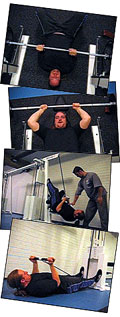 Even a two-day autumn holiday couldn’t keep me away from the customary Friday training at school. Had the unusual luxury of a training partner as Måns joined me. Fulfilling my usual oddball wishes, he climbed up on the rack to film the floor press sets from above. I’ve never taken clips from this angle before, but seeing the result I would argue that this is the best angle for assessing bar path. Turns out I press more towards the head than I thought. This is not necessarily a bad thing in itself as there are several schools of thought on what the optimal bar path is, but it does shatter the myth of me being a straight up and down presser, at least as far as the close-grip bench is concerned. With rapidly increasing gains - smashed the 85 kg/188 lbs on all four sets easily today - I will not play around with bar path at this point, but down the line this might turn out to be the ticket to some extra kilos. Also had the triceps extensions taped from the same angle and … well, suffice it to say that I am not a well-oiled repping machine just yet as evidenced by some rather frisky bar swaying.
Even a two-day autumn holiday couldn’t keep me away from the customary Friday training at school. Had the unusual luxury of a training partner as Måns joined me. Fulfilling my usual oddball wishes, he climbed up on the rack to film the floor press sets from above. I’ve never taken clips from this angle before, but seeing the result I would argue that this is the best angle for assessing bar path. Turns out I press more towards the head than I thought. This is not necessarily a bad thing in itself as there are several schools of thought on what the optimal bar path is, but it does shatter the myth of me being a straight up and down presser, at least as far as the close-grip bench is concerned. With rapidly increasing gains - smashed the 85 kg/188 lbs on all four sets easily today - I will not play around with bar path at this point, but down the line this might turn out to be the ticket to some extra kilos. Also had the triceps extensions taped from the same angle and … well, suffice it to say that I am not a well-oiled repping machine just yet as evidenced by some rather frisky bar swaying.
Leaving the camera on autopilot on top of the rowing machine, Måns next stepped in to stabilize a set of modified rows with the 100 kg/221 lbs stack. Like last week, I still had to press very hard against the post to stay put, but the extra support did allow a decent nine reps without a painful calf cramp. A single set of lying cable curls and the time was unfortunately up. I leave the hardcore readers with this 3.9M clip.
Last week Scott inquired about the width of my close grip. After measuring it on the actual bar, I can now say that my current grip (middle fingers on the edge of the smooth part of the bar) is 36 cm/14″ between the index fingers with my usual close grip (index fingers on smooth) being 42.5 cm/16.6″. My wide grip measured a narrow 66.5 cm/25.9 ” between the index fingers - a light-year from the maximum competition grip of 81 cm/32″. Based on Ryan Kennelly’s formula (medium grip is 2″/5.1 cm in from wide grip and close grip 2″ further in), a 66.5 cm/25.9″ wide grip would yield a 55.6 cm/21.9″ medium grip and a 45.5 cm/17.9″ close grip. In a follow-up post aptly titled How close is close?, Scott also brought forward an interesting formula based on research presented by Rob Wagner in the June 2003 issue of Powerlifting USA:
Let me define a narrow and wide grip. In two separate studies, researchers determined narrow grip as the distance between your acromion processes (slide you hand down your trap and the bony bump you hit is the acromion). They then applied this measurement to the hand spacing (distance between index fingers) on the bar. Wide grip was two times the narrow grip distance. Both groups of researchers found that grips that were 1.65 to 2 times their narrow grip were the most effective strength wise. The way you can determine your grip is to measure the distance between your acromion processes. Now measure the distance between your index fingers when you bench. Divide the bench distance by the acromion distance and if your number is between 1.65 and 2.00 you are in an optimal position
[studies referenced: Clemons, J. & Aaron, C., Effect of grip width on the myoelectric activity of the prime movers in the bench press. Journal of Strength and Conditioning Research, 11(2), 1997 / Wagner, L.L., Evans, S.A., Weir, J.P., Housh, T.J. & Johnson, G.O., The effect of grip width on bench press performance. International Journal of Sports Biomechanics 8(1), 1992]
Since I measured my acromion distance at 36 cm/14″ (FWIW, Sanna’s was 31 cm/12.1″), my wide grip fits well into the predicted ideal pressing width of 59-72 cm/23-28.1″. Enough number crunching for today, my head hurts.
Floor press, close-grip: 6,6,6,6 @ 85 kg/188 lbs
Triceps extensions, behind head: 6,6,4,3 @ 42.5 kg/94 lbs
Modified row, partner supported: 9 @ 100 kg/221 lbs
Lying cable curl: 10 @ 70 kg/155 lbs
Total training time: 37 min
October 21, 2004
Last chance to buy Blakley’s XTM video?
The other day I got an e-mail from a reader desperate to find JM Blakley’s XTM bench video. He had even tried reaching JM on the phone to no avail. The thing is, this video is really hard to find. JM’s own site has been down for months now and can only be enjoyed via the Wayback machine. The only place I know of that still stocks the tape is Voimaharjoittelu.net, an online web store owned by Finnish Westside enthusiast Sakari Selkäinaho. It turned out they still had a few copies left in stock, but were now selling them off at a discount of 49 euros. After contacting Sakari, the reader did manage to secure a copy.
According to the discount page, there are still 8 tapes in stock. For some unfathomable reason, the tape only appears on the Finnish version of the discount page. I have no vested interested in this, but thought I’d pass this info on in case somebody wants a copy of this very informative tape from where my current bench program has been ripped (also has great footage of the JM press). In a worst case scenario, this might be the last chance you’ll ever get. And no, I’m not selling my copy.
October 20, 2004
Sitting in the lion’s den
Quadzilla’s revenge was a not all that ruthless, but I did have far too sore legs to battle in that arena. Instead did some standard stuff on the swiss ball before moving on to some light posterior chain work. Even did some seated good mornings working up to the same weight I used the first time I tried them back when dinosaurs still roamed the land. 40 kg/88 lbs felt light enough, but since I’m still battling the residue of a good morning injury it did feel a little like sitting down in the wrong neighborhood. It is funky as a mobility exercise, and will probably not go much heavier in the near future.
Arm rotations and other warm-up movements kneeling on stability ball
Arm and leg extension kneeling on stability ball: 3x16
Seated good morning:
15 @ 20 kg/44 lbs
15 @ 30 kg/66 lbs
15 @ 40 kg/88 lbs
Low cable twist (slow): 10 @ 30 kg/66 lbs
Upper body cable turn:
15 @ 40 kg/88 lbs
20 @ 50 kg/111 lbs
Seated calf raise: 2x10 @ 75 kg/166 lbs
Total training time: about 40 minutes
October 18, 2004
In need of vitamins
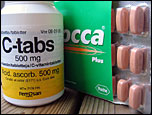 Call me schizophrenic or talk about yin and yang - the fact remains that this bench workout was less than stellar. Perhaps I hadn’t recovered sufficiently from my high-rep floor pressing on Friday or perhaps it was the accidental misloading of the bar on the first single - when I mistakenly put 5 kg too much on the right side of the bar causing it to droop severely at a total load of 100 kg/221 lbs - that sunk the ship. Whatever the reason, I bailed out after I narrowly failed on the subsequent 95 kg/210 lbs single and only got four reps on my first go at 82.5 kg/182 lbs. Took refuge in some lat and grip work. Then went to the pharmacy to pick up some multivitamins and a bottle of C, both of which I have been out of for a couple of weeks.
Call me schizophrenic or talk about yin and yang - the fact remains that this bench workout was less than stellar. Perhaps I hadn’t recovered sufficiently from my high-rep floor pressing on Friday or perhaps it was the accidental misloading of the bar on the first single - when I mistakenly put 5 kg too much on the right side of the bar causing it to droop severely at a total load of 100 kg/221 lbs - that sunk the ship. Whatever the reason, I bailed out after I narrowly failed on the subsequent 95 kg/210 lbs single and only got four reps on my first go at 82.5 kg/182 lbs. Took refuge in some lat and grip work. Then went to the pharmacy to pick up some multivitamins and a bottle of C, both of which I have been out of for a couple of weeks.
Bench pattern warm-up:
10 @ 20 kg/44 lbs
6 @ 40 kg/88 lbs
5 @ 50 kg/111 lbs
3 @ 60 kg/133 lbs
2 @ 70 kg/155 lbs
2 @ 80 kg/177 lbs
Heavy bench singles, paused:
0 @ 100 kg/221 lbs (5 kg too much on right side)
0 @ 95 kg/210 lbs
Wide-grip pulldown, front: 4x8 @ 105 kg/232 lbs
Side cable raise, behind back: 12 @ 15 kg/33 lbs
Reverse plate curl: 2x8 @ pinch gripping 5 kg/11 lbs plate
Plate curl:
3,1 @ pinching 10 kg/22 lbs plate
10 @ pinch gripping 5 kg/11 lbs and 2.5 kg/6 lbs plates
Rolling Thunder:
4,4,3 @ 40 kg/88 lbs
holds @ 40 kg/88 lbs
Total training time: 65 min
